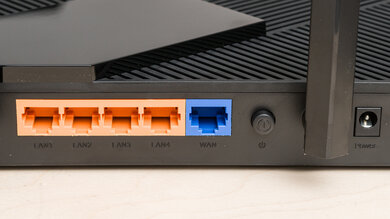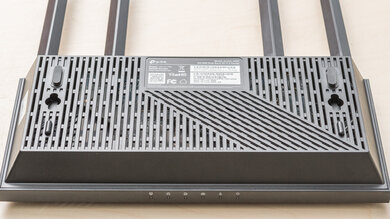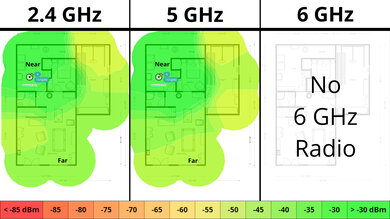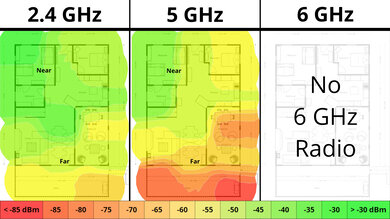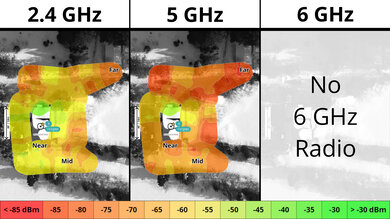The TP-Link Archer AX21, also known as the TP-Link AX1800, is a dual-band Wi-Fi 6 router with 2.4GHz and 5 GHz bands. It supports WPA3 security and OneMesh technology, allowing you to configure a mesh network with one of TP-Link's Wi-Fi extenders.
Our Verdict
The TP-Link AX1800 is a decent router if you live in an apartment, condo, or single-story home. It provides good top speeds suitable for fast downloads and streaming 4k content. It's a reasonable size that will fit into most living spaces, and it also has screw head slots on the bottom, so you have the option to mount it on the wall or ceiling. That said, it lacks Dynamic Frequency Selection (DFS) support, meaning it can't use the often less congested DFS-only channels, which would help if you live in a congested wireless environment like an apartment building.
-
Good top speeds.
-
Lacks DFS support, so it can't avoid more congested channels.
-
Wi-Fi 6 won't take full advantage of new Wi-Fi 6E or 7 devices.
The TP-Link AX1800 is a decent router for use in a multi-level home. It provides good top speed and is suitable for fast downloads when you're close to it with few obstacles in the way. That said, it's a standalone router, and its range is just okay, so you'll experience slowdowns if you have a very large house and are far from where you've placed it.
-
Good top speeds.
-
Lacks DFS support, so it can't avoid more congested channels.
-
Standalone router that may have deadzones if you have a very large home.
-
Wi-Fi 6 won't take full advantage of new Wi-Fi 6E or 7 devices.
The TP-Link AX1800 delivers good speeds suitable for an internet connection of up to ~700 Mbps. Unfortunately, it lacks Dynamic Frequency Selection (DFS) support, so it can't use the often less congested DFS-only channels, which would help if you live in a congested wireless environment. Also, it's only Wi-Fi 6, so it doesn't have a faster 6GHz band for your Wi-Fi 6E or 7 devices to take advantage of.
-
Good top speeds.
-
Lacks DFS support, so it can't avoid more congested channels.
-
Wi-Fi 6 won't take full advantage of new Wi-Fi 6E or 7 devices.
The TP-Link AX1800 has adequate range for a standalone router, but you might not be able to reach your internet plan's maximum speed if you're far away from it or have solid obstacles in the way, like concrete or masonry walls. That said, you can add a compatible OneMesh range extender to create a mesh network for better range.
-
Standalone router that may have deadzones if you have a very large home.
-
Wi-Fi 6 won't take full advantage of new Wi-Fi 6E or 7 devices.
Changelog
-
Updated Jun 12, 2025:
We've added a link to the newly reviewed GL.iNet Beryl AX (GL-MT3000) in the Network Ports section of the review.
- Updated May 01, 2025: We've converted this review to Test Bench 0.8.1. This includes a new test result for our Test Configuration box.
- Updated Jul 22, 2024: Review published.
Check Price
Differences Between Sizes And Variants
The TP-Link Archer AX21 has no variants but is also often referred to as the TP-Link AX1800.
Here's a photo of our unit's label.
Popular Routers Comparisons
The TP-Link Archer AX21 is a mainstream Wi-Fi 6 router in a competitive mid-range price bracket. This router offers several features, like the newest WPA3 security standard, support for TP-Link's OneMesh technology for connecting range extenders, beamforming, OFDMA (orthogonal frequency-division multiple access), and more.
It offers network coverage performance and features similar to those of other Wi-Fi 6 routers in its price category. Notably, it performs similarly to the lower-end TP-Link Archer AX10 and slightly better than the ASUS RT-AX1800S. Overall, it's a good choice if you want a solid-performing router and haven't yet upgraded many of your devices to a newer Wi-Fi standard like Wi-Fi 6E or 7.
For more recommendations, check out the best Wi-Fi 6 routers, the best Wi-Fi routers, or the best routers for streaming.
The TP-Link Archer AX21 and the TP-Link Archer AX10 are standalone Wi-Fi 6 routers. The AX10 is a budget router, while the AX21 is a lower mid-range model. The two perform very similarly, but the AX10 has a slightly better range.
Test Results
This is a standalone router, so the mesh satellite position line on this graph isn't applicable.
This is a standalone router, so the mesh satellite position line on this graph isn't applicable.
Comments
TP-Link Archer AX21: Main Discussion
Let us know why you want us to review the product here, or encourage others to vote for this product.
Update: We’ve added a link to the newly reviewed GL.iNet Beryl AX (GL-MT3000) in the Network Ports section of the review.
- 21010
Here is the back ports of the router.



